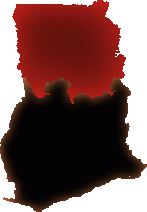|
 For
those that want to experience real Ghana in all it's beauty and
splendour - this is the place to go. The northern region of
Ghana is the region which has not been influenced by Colonialism
and other European traditions. Here time has turned very slowly
and as such has preserved tradition, culture and most of all the
land and it's people. For
those that want to experience real Ghana in all it's beauty and
splendour - this is the place to go. The northern region of
Ghana is the region which has not been influenced by Colonialism
and other European traditions. Here time has turned very slowly
and as such has preserved tradition, culture and most of all the
land and it's people.
In the
beginning of the Colonial Era, the area to the north of the
Ashanti Region did not belong to the Crown Colony Gold Coast. It
was during the years when Britain, Germany and France started
competing in conquering as many African countries as possible
that each country sent out people to the Kings of these areas to
sign Protection Papers and through that join one of the three
Western Countries of Power. George Ekem Ferguson , a Ghanaian
originating from Anomabu in the Central Region born to a
Ghanaian mother and British father was sent to the North and won
the Kings over to the side of the British. Burkina Faso joined
the French and Togo the Germans. In 1954 the Northern
Territories were formally added to the other regions of Ghana
but was more or less ignored by the Foreigners as this region
did not have resources in Gold, Cocoa, Diamonds, Ivory and Wood.
Maybe this is one of the explanations to the fact that the
region and it's people have remained true to nature.
Actually
the north of Ghana is divided into three - The Northern Region
with Tamale as it's capital city, the Upper West Region with
it's capital city Wa and the Upper East Region with it's capital
city Bolgatanga. Once you leave the south of Ghana and it's
rainforest areas and densely populated landscape you enter a
different world. The first thing you will notice are the vast
empty landscapes with occasional trees doting the horizon. The
Sahel has great influence here. The architecture also changes
from that of the south and takes on the forms of the Kraal. The
next thing to change is the weather - during the day it is
really hot and in the evening the temperature drops drastically,
the sun is more intensive and the air becomes very dry. During
the dry season between November and June the only vegetation to
survive are shrubs and trees like Kola Nut, Shea Butter, Baobab
and Neem Trees. The Savanna is home to many species of plants
and animals never seen in other parts of Ghana.
The Volta
Rivers are natural borders between the regions. The Black River
reaches down to the beginning of the Brong Ahafo and Volta
Regions, the Volta Lake stretches its eastern arms to Yapei
along the White Volta about 52 km away from Tamale and its
western arm reaches to Buipe at the edge of the Black Volta 100
km away from Tamale. The only mountains in this otherwise flat
landscape are the Gamba Highlands which are 300 - 400 meters
above sea level and a smaller one of 180 meters in the Sawla
Area which connects to the Wa Plateau. Apart from the Volta
River and the Volta Lake there are no larger rivers in the north
as they all dry up during the dry season.
As the
north does not have natural resources like Gold or Wood and did
not have enough water sources to farm, they have not been too
lucky concerning their economy. This has changed for the better
in the past years due to better water systems. Cotton
Plantations and Rice Fields were started and are a great
success. Beside this the northern region provides Kola Nut, Shea
Butter, Tobacco, Maize, Sorghum, Wheat and other Agricultural
products like Yam and Beans. Here again the Volta Lake is a
connection to the south as the goods are transported down on the
Yapei Queen during a two day trip down the Volta Lake.
From the
Northern Region we select some sightseeing's.
|
The
Mole
National Park
Mole
National Park is Ghana's largest wildlife refuge. The park is located in
northwest Ghana on grassland savanna and riparian ecosystems at an elevation
of 150 m, with sharp escarpment . . . |
|
The
Larabanga
Mosque
The
Larabanga mosque is one of the oldest mosques in West Africa and is the
oldest mosque in Ghana. Each year the Larabanga mosque must be renovated due
to damage to the mud walls . . . |
|
Paga's Holy Crocodiles
Paga is a town in northern Ghana, lying where the nation's
main north-south road reaches the Burkina Faso border, north of Bolgatanga. There are plans to extend the Kumasi-Takoradi
railway to Paga. . . . |
|
The
Wechiau Hippo
Park
The Wechiau community is
primarily inhabited by the Lobi people although the land belongs
to the Wala people and the Lobi compensate the Wala chief for
use of the land. Established in . . . |
|
On the Volta
Lake
The Dodi
Princess, which predates the relationship between Princess Diana
and Dodi Al-Fayed, is a modern passenger cruise ship built in
1991 with an insured passenger capacity passengers. Dodi as an
island in the . . . |
|